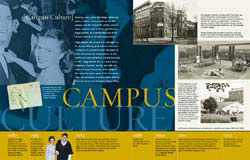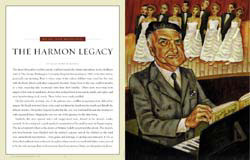Postmarks
Kudos for Common Ground

The spring 2002 issue arrived yesterday, and I couldn’t put it down. The “Common Ground” article is impressive indeed, not just for the history but for the vivid description of the current state of the campus. Bravo!
Frank Farina, MBA ’75
I am glad to see that while GW has grown, it has maintained the same neighborhood atmosphere it had in the ’40s and ’50s. I wish I were close enough to participate in the alumni activities.
Lois N. Webb, BA ’57
I especially enjoyed the spring 2002 edition of the GW Magazine. I spent hours looking at “Common Ground” and appreciating the photos of GW in the days when I was a student. This special section is wonderful. The photos are outstanding in showing how things were and how they are. And the text supplies many facts that tell an impressive story of both the University and its geographical home-area. I found it quite amazing that during the 90 years, three men have served as University president for a total of 69 years. The efforts of Marvin, Elliott, and Trachtenberg have done much to define the “common ground.”
George W. Nordham, BA ’49
Remembering “Doc”

The most recent issue of the GW Magazine was truly one of your best. We are so interested in the article about Doc Harmon and the bust of him sculpted by John Parker, as we are former members of Doc’s singing groups of the ’50s.
Patricia A. (Taylor) Young, BA ’56
While not a singer, I met Doc Harmon through student government in the late 1950s. Later, as assistant to the director of men’s activities and manager of Adams Hall (on the corner of 19th and H Streets), I occasionally called Doc Harmon to come to Adams Hall to assist in one or another student’s medical need. He made “house calls” cheerfully.
On one of those trips to Adams Hall, Doc Harmon commented on changes in pole vaulting. When he was a pole vaulter, vaulters ran down a grassy runway, carrying an oak pole with a spike on the end. They jammed the spike into the ground and then swung themselves over the bar. As heights increased during the competition, the ground at the end of the runway became chewed up as a result of the constant spiking. Successful vaulters had to find places farther and farther from the center of the runway. If recollection serves me, Doc told me that he was one of four persons to pole vault over 11 feet. Compared to the slingshot of vaulters with light, graphite poles, I think 11 feet is quite an accomplishment.
Your article on Doc Harmon was an excellent piece of GW memorabilia. His contribution was not limited to the Troubadours but extended across the range of University life.
Tim Mead, PhD ’69
Praise
I want to let you know that I read GW Magazine and I think that you and your staff do an excellent job. Keep up the great work!
Stuart Portnoy, MD ’91
Did We Forget Ali?
In the spring 2002 issue you provide a listing of some of the famous individuals who have appeared at Lisner Auditorium. I don’t know if your omission of Muhammad Ali’s appearance in, if I remember correctly, 1968, after he had been stripped of the World Heavyweight Championship, was a purposeful one or not. I certainly remember it as one of the highlights of my GW years.
Jonathan M. Rogoff, BA ’69
The editor replies:
The omission of Mr. Ali was simply the result of a random selection from among hundreds of famous performers in many fields who have appeared at Lisner—among them Victor Borge, the Preservation Hall Jazz Band, Mikhail Baryshnikov, and Odetta. The Lisner list was introduced in “Common Ground” as a “sampling” because, unfortunately, that was all we had space for.